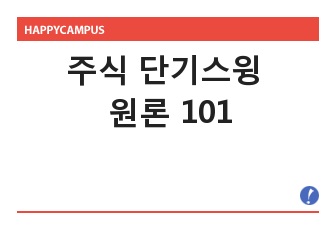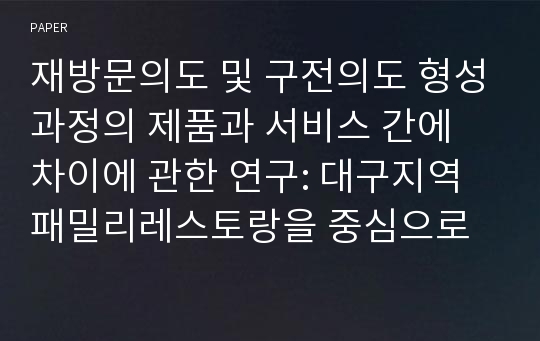재방문의도 및 구전의도 형성과정의 제품과 서비스 간에 차이에 관한 연구: 대구지역 패밀리레스토랑을 중심으로
*기*
다운로드
장바구니
소개글
본 연구는 패밀리 레스토랑의 서비스품질과 음식품질이 각각의 서비스품질만족, 음식품질만족에 미치는 영향력의 관계를 확인하고, 서비스품질과 음식품질이 재방문의도 및 구전의도에 미치는 간접적인 영향력의 관계는 어떠한지 살펴보고자 한다. 아울러 음식품질만족과 서비스품질만족이 재방문의도 및 구전의도에 어떠한 영향력의 관계를 가지는지 살펴보고자 하였다. 본 연구는 재방문의도 및 구전의도에 결정요인을 규명하여 효율적인 경영전략을 제시함으로써 기업의 이익을 극대화 할 수 있는 이론적, 실무적 시사점을 제공하는데 의의가 있다.목차
Abstract서 론
Ⅱ. 이론적 배경
1. 서비스품질과 음식품질
2. 고객만족
3. 재방문의도
4. 구전의도
Ⅲ. 연구의 설계
1. 연구모형
2. 가설의 설정
3. 변수의 조작적 정의 및 설문지 구성
4. 표본설계 및 자료수집
Ⅳ. 분석결과
1. 응답자의 인구통계적 특성
2. 서비스품질에 대한 탐색적 요인분석
3. 확인적 요인분석
4. 공분산 구조분석에 의한 가설검정
Ⅴ. 결론 및 시사점
참고문헌
본문내용
AbstractThis study examined impact of food and service quality on customers’ satisfaction in order to identify decisive factors for repeat-visit and word-of-mouth advertisement of family restaurants. The study also examined indirect influence of service and food quality on intent of repeat-visit and word-of-mouth. In addition, the study inquired how customers’ satisfaction with service and food quality affects intent for future visit and word-of-mouth. The participants in the study included customers of family restaurants in Daegu region, and a total of 271 questionnaires were analyzed using SPSS 14.0 and AMOS 16.0.
The analysis result demonstrated that quality of service and food has significant effect on customers’ satisfaction with service and food respectively. In terms of magnitude, service quality had greater impact than food quality on customer satisfaction. Satisfaction with service and food both showed significant indirect influence on customers’ intent of repeat-visit and word-of-mouth. Food quality had greater impact than service quality. As a result of this research, food service industry should had to more invest to improve for food quality.
<중 략>
고객의 마음을 얻기 위해서는 고객의 needs 와 wonts를 파악하여 고객의 오감을 만족시키는 제품과 서비스를 제공해야한다. 이는 고객들의 소비를 자연스럽게 유도할 수 있을 것이다. 따라서 본 연구에서는 패밀리 레스토랑의 서비스품질과 음식품질이 각각의 서비스품질만족, 음식품질만족에 미치는 영향을 확인하고, 이러한 품질과 만족간의 간접적인 효과가 재방문의도 및 구전의도에 어떠한 영향을 미치는지 살펴보고자 하였다. 아울러 음식품질만족과 서비스품질만족이 재방문의도 및 구전의도에 어떠한 영향관계를 가지는지 살펴보고자 하였다.
참고 자료
권미영⋅정해경⋅한동여(2006). 패밀리레스토랑의 서비스품질이 고객만족과 재방문의도에 미치는 영향에 관한 연구. 『한국경영교육학회』44: 65-92.김계수(2004). 『AMOS 구조방정식 모형』서울: 한나래.
김기진⋅이보순(2009). 커피전문점의 재방문의도 및 구전의도 형성과정에 관한 연구. 『외식경영학회』12(4): 7-31.
김동수(2007). 외식소비자의 라이프스타일에 따른 서비스품질이 고객만족 및 재방문의도에 관한 연구. 경기대학교 박사학위논문.
김태희⋅이묘숙⋅최동주(2004). DINESERV를 이용한 한식당의 서비스품질에 관한 연구. 『외식경영학회』7(3): 7-25.
이귀옥⋅강인호(2004). 호텔 서비스 품질이 고객만족과 재방문, 추천의도에 미치는 영향 -경주 G 호텔을 중심으로. 『호텔경영학연구』13(2): 17-35.
이애주⋅박대환⋅박진우(2003). 외식업체의 서비스품질이 고객만족과 재방문의도, 구전의도에 미치는 영향 -부산지역 패밀리레스토랑을 중심으로. 『호텔경영학연구』12(1): 191-213.
이유재(1994a). 고객만족의 결정변수에 대한 이론적 고찰. 『경영논집』28(1-2): 90-123.
이유재(1994b). 고객만족의 결과변수에 대한 이론적 연구. 『경영논집』28(3-4): 201-232.
이유재(1995). 고객만족의 정의 및 측정에 관한 연구. 『경영논집』29(1-2): 145-168.
이유재(1997). 고객만족형성과정의 제품과 서비스간 차이에 대한 연구. 『소비자학연구』8(1): 101-118.
이유재(2008). 『서비스 마케팅 제4판』파주: 학현사.
이유재⋅김주영⋅김재일(1996). 서비스산업의 현황에 대한 실증연구. 『소비자학연구』7(2): 129-157.
이은지⋅이준혁(2007). 호텔 이미지 요인이 고객만족, 재방문의도, 추천의도에 미치는 영향에 관한 연구 -부산지역 특급 호텔을 중심으로. 『호텔경영학연구』16(4): 47-60.
이학식(1997). 지각된 서비스품질의 결정과정 -판단이론적 시각. 『경영학연구』26(1): 139- 154.
이종은(2007). 커피전문점의 서비스품질이 고객만족과 재방문의도에 미치는 영향에 관한 연구. 한양대학교 석사학위논문.
임종원⋅김재일⋅홍성태⋅이유재(2007). 『소비자 행동론』 제3판. 서울: 경문사, 474.
장대성⋅Shnicderjans, M. J.⋅홍석기(1996). 서비스시스템에 Just-in-Time의 적용 -올드컨추리 뷔페식당 사례연구. 『한국생산관리학회』7(1): 203-231.
장대성⋅박상화⋅김영택(2001). 한국패밀리 레스토랑의 고객분석 및 주요 서비스품질에 관한 연구 -A 패밀리 레스토랑 체인을 중심으로. 『한국생산관리학회』12(2): 129-156.
장대성⋅박주영⋅김두복(2002). 한국패스트푸드점 서비스품질 측정에 있어서 SERVQUAL과 SERVPERF의 비교연구. 『경영과학』19(2): 59-73.
전인순⋅이재섭⋅노민경(2007). 한식당 서비스품질과 서비스가치에 대한 외래 관광객 반응 연구. 『호텔경영학연구』16(4): 185-200.
정경희(2004). 패밀리 레스토랑 서비스 품질이 고객만족과 재방문 의도에 미치는 영향. 『한국조리학회지』10(4): 84-95.
한상린(2004). 레스토랑의 서비스품질이 고객유지와 구전에 미치는 영향 -관계적 요인의 매개효과를 중심으로. 『마케팅관리연구』9(1): 29-46.
Anderson, J. C. & Gerbing, D. W.(1988). Structural equation modeling in practice: A review and recommended two-step approach. Psychology Bulletin, 103(3): 411-423.
Barnes, J. G. & Glynn, W. J.(1993). The Customer Wants Service: Why Technology is no Longer Enough. Journal of Marketing Management, 9(1): 43-53.
Bearden, W. O. & Teel, J. E.(1983). Some Determinants of Consumer Satisfaction and Complaint Reports. Journal of Marketing Research, 20(1): 21-28.
Becker, W. S. & Wellins, B. H.(1990). Customer- Service Perceptions and Reality. Training and Development Journal, 44(3): 49-51.
Bitner, M. J.(1990). Evaluating Service Encounters: The Effects of Physical Surroundings and Employee Responses. Journal of Marketing, 54(2): 69-82.
Blodgett, J. G.(1994). The Effects of Perceived Justice on Complainants` Repatronage Intentions and Negative Word-of-Mouth Behavior. Journal of Consumer Satisfaction. Dissatisfaction and Complaining Behavior, 7: 1-14.
Bollen, K. A.(1989). Structural equations with latent variables. New York: Wiley.
Bolton, R. N. & Drew, J. H.(1991a). A Longitudinal Analysis of the Impact of Service Changes on Customer Attitudes. Journal of Marketing, 55(1): 1-9.
& (1991b). A Multistage Model of Customers` Assessments of Service Quality and Value. Journal of Consumer Research, 17(March): 375-384.
Boulding, W., Kalra, A., Staelin R., & Zeithaml, V. A.(1993). A Dynamic Process Model of Service Quality: From Expectations to Behavioral Intentions. Journal of Marketing Research, 30(February): 7-27.
Brown, S. W. & Swartz, T. A.(1989). A Gap Analysis of Professional Service Quality. Journal of Marketing, 53(April): 92-98.
Cadotte, E. R. & Turgeon, N.(1988). Key factors in guest satisfaction. Cornell Hotel and Restaurant Administration Quarterly, 28(4): 45-56.
Carman, J. M.(1990). Consumer Perceptions of Service Quality: An Assessment of the SERVQUAL Dimensions. Journal of Retailing, 66(1): 33-55.
Collier, D. A.(1995). Modeling the Relationships Between Process Quality Errors and Overall Service Process Performance. International Journal of Service industry Management, 6(4): 4-19.
Cronin, J. J. & Taylor, S. A.(1992). Measuring Service Quality: A Reexamination and Extension. Journal of Marketing, 56(July): 55-68.
& (1994). SERVPERF Versus SERVQUAL: Reconciling Performance-Based and Perceptions-Minus-Expectations Measurement of Service Quality. Journal of Marketing, 58(January): 125-131.
Day, R. L.(1980). Research Perspectives on Consumer Complaining Behavior. Chicago, IL: Theoretical Developments in Marketing, Lamb, C. W. and Dunne, P. M.(Eds), American Marketing Association, 211-215.
Engel, J. F. & Blackwell, R. D.(1978). Consumer Behavior, New York: Holt, Rinehart, and Winston.
Fornell, C. & Larcker, D. F.(1981). Evaluating structural equation models with unobservable and measurement error. Journal of Marketing Research, 18(1): 39-50.
Grönroos, C.(1990). Service Management and Marketing: Managing the Moment of Truth in Service Competition. Lexington, MA: Lexington Books.
Gummesson, E.(1994). Service Management: An Evaluation and the Future. International Journal of Service Industry Management, 5(1): 77-96.
Hair, J. F., Anderson, R. E., Tatham, R. L., & Black, W. C.(1998). Multivariate data analysis: with readings. (5th edn.), New York: Prentice-Hall.
Hart, C. W., Heskett, J. L., & Sasser, W. E.(1990). The Profitable art of Service Recovery. Harvard Business Review, 68(4): 148-156.
Howard, J. A. & Sheth, J. N.(1969). The Theory of Buyer Behavior. New York: Wiley.
Jones, T. O. & Sasser, W. E.(1995). Why Satisfied Customer Defect. Harvard Business Review, 73(6): 88-99.
Keaveney, S. M.(1995). Customer Switching Behavior in Service Industries: An Exploratory Study. Journal of Marketing, 59(2): 71-82.
Lehmann, D. R. & Winer, R. S.(1994). Product Management(3rd ed.). New York: McGrawHill.
Lundeen, H. K., Harmon, L. C., & McKenna-Harmon, K. M.(1995). Service Recovery in commercial real estate management. Journal of Property Management, 60(3): 30-32.
MacLaurin, D. J., & MacLaurin, T. L.(2000). Customer perceptions of theme restaurants in Singapore. Cornell Hotel and Restaurant Administration Quarterly, 41(3): 75-85.
Morgan, M. S.(1993). Benefit dimensions of midscale restaurant chains. Cornell Hotel and Restaurant Administration Quarterly, 34(2): 40-45.
Oliver, R. L.(1980). A Cognitive Model of the Antecedents and Consequences of Satisfaction Decisions. Journal of Marketing Research, 17(4): 460-469.
Oliver, R. L. & Swan, J. E.(1989). Consumer Perceptions of Interpersonal Equity and Satisfaction in Transactions: A Field Survey Approach. Journal of Marketing, 53(2): 21-35.
Parasuraman, A., Zeithaml V. A., & Berry, L. L.(1985). A Conceptual Model of Service Quality & Its implications for Future Research. Journal of Marketing, 49(4): 41-50.
, , & (1988). SERVQUAL: A Multiple-Item Scale for Measuring Consumer Perceptions of Service Quality. Journal of Retailing, 64(1): 12-40.
, , & (1991). Refinement and Reassessment of the SERVQUAL Scale. Journal of Retailing, 67(4): 420-450.
, , & (1994). Reassessment of Expectations as a Comparison Standard in Measuring Service Quality: Implications for Further Research. Journal of Marketing, 58(1): 111-124.
Reidenbach, R. E. & Sandifer-Smallwood, B.(1990). Exploring Perceptions of Hospital Operations by a Modified SERVQUAL Approach. Journal of Health Care Marketing, 10(4): 47-55.
Rust, R. T., Zahorik, A. J., & Keiningham, T. L.(1995). Return on Quality(ROQ): Making Service Quality Financially Accountable. Journal of Marketing, 59(April): 58-70.
Shostack, G. L.(1977). Breaking Free from Product Marketing. Journal of Marketing, 41(2): 73-80.
Singh, J.(1990). A Typology of Consumer Dissatisfaction Response Styles. Journal of Retailing, 66(1): 57-99.
Stine, R.(1989). An Introduction to Bootstrap Methods: Examples and Ideas. Sociological Methods & Research, 18(2,3): 243-291.
Taylor, S. A. & Baker, T. L.(1994). An Assessment of the Relationship Between Service Quality and Customer Satisfaction in the Formation of Consumers Purchase Intentions. Journal of Retailing, 70(2): 163-178.
Teas, R. K.(1993). Expectations, Performance Evaluation, and Consumers` Perceptions of Quality. Journal of Marketing, 57(October): 18-34.
(1994). Expectations as a Comparison Standard in Measuring Service Quality: An Assessment of a Reassessment. Journal of Marketing, 58(1): 132-139.
Vargo, S. L. & Lusch R. F.(2004). Evolving to a New Dominant Logic for Marketing. Journal of Marketing, 68(1): 1-17.
Woodside, A. G., Frey, L. L., & Daly, R. T.(1989). Linking Service Quality, Customer Satisfaction and Behavioral Intention. Journal of Health Care Marketing, 9(4): 5-17.
Zeithaml, V. A. & Bitner M. J.(1996). Services Marketing. New York, NY: McGraw-Hill, 8.



























